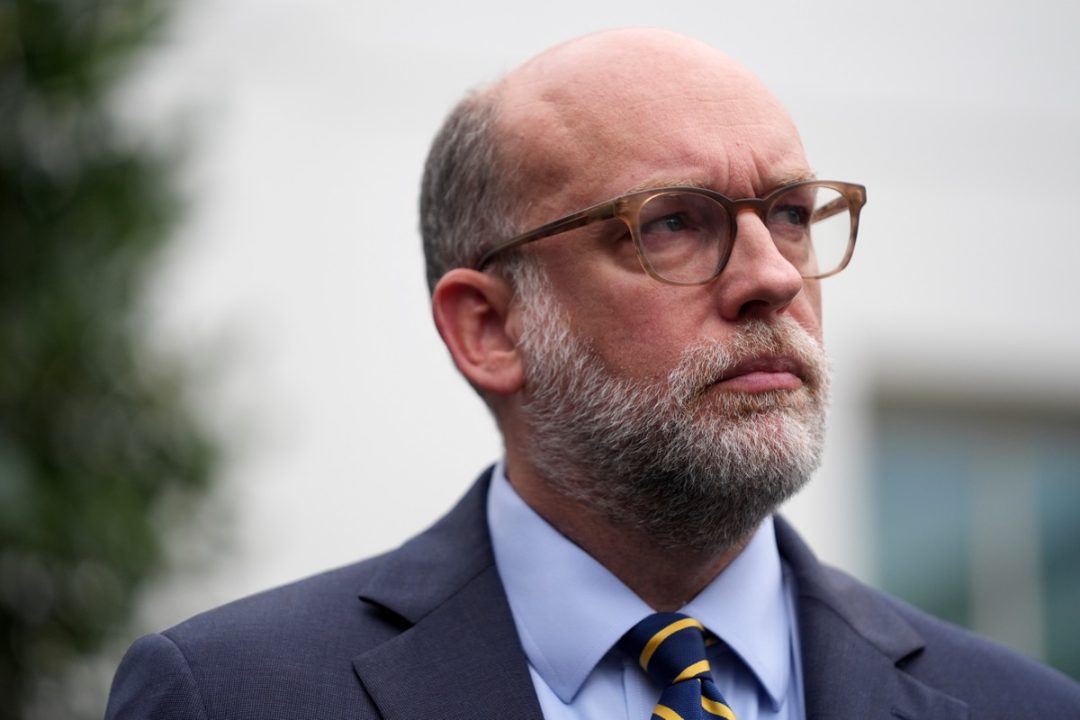
President Donald Trump has moved from loudly denying ties to the controversial Project 2025 to openly stressing his administration’s alignment with it. Central to that shift is Russ Vought, now Trump’s director of the Office of Management and Budget (OMB). On Thursday, Trump underscored the point in a post on Truth Social, praising Vought as the architect of major spending cuts:
I have a meeting today with Russ Vought, he of PROJECT 2025 Fame, to determine which of the many Democrat Agencies, most of which are a political SCAM, he recommends to be cut, and whether or not those cuts will be temporary or permanent.
In a subsequent AI-generated clip, Vought appears as the “grim reaper” who wields “the pen, the funds, and the brain.”
It is a fact that as much as 80 percent of the federal bureaucracy operates outside clear constitutional authority, and reform is long overdue. Yet Vought’s agenda goes far beyond trimming excess. His vision is a wholesale restructuring of how executive power operates, how agencies function, and how citizens relate to their government. That includes a fundamental shift in the balance between the legislative and executive branches.
What’s Happening
On Wednesday, the federal government entered a partial shutdown following congressional failure to pass appropriations for fiscal 2026. Trump has seized on the impasse to push a dramatic downsizing agenda.
According to reports first published by Politico and highlighted by Government Executive, Vought instructed agencies to prepare reduction in force (RIF) plans for employees whose work “is not consistent with the President’s priorities.” Even workers in “excepted” programs — normally shielded during funding lapses — could be targeted. Indeed, reports suggest the administration is preparing mass layoffs of federal workers, potentially permanent dismissals, especially at what Trump labels “Democrat agencies.” Departments like education, labor, housing, and environmental protection are among those marked for deep cuts or functional shutdowns.
In addition to workforce reductions, OMB has begun freezing major spending streams in “Democratic” states. More than $2.1 billion in infrastructure funding was halted in Chicago, alongside $18 billion for transit projects in New York. Vought also announced that “nearly $8 billion in Green New Scam funding to fuel the Left’s climate agenda is being cancelled” in 16 states. All of them voted for former Vice President Kamala Harris in 2024. The selective nature of the cuts raises an obvious question: If the climate agenda is truly a “scam” (and it is), why allow similar funds to continue flowing in Republican states?
Who’s Russ Vought
Russell “Russ” Vought is a longtime Washington insider. He served as deputy director of the Office of Management and Budget (OMB) from 2018 to 2020, and briefly as acting director. He pushed Schedule F reclassification to weaken civil-service protections and elevate OMB as the executive branch’s control hub.
After leaving government, Vought joined the Heritage Foundation. He later founded the Center for Renewing America, becoming a principal architect of Project 2025 and writing large portions of its executive-branch agenda.
Trump nominated him to return as OMB director in early 2025, and the Senate confirmed him on February 6 by a 53-47 vote. Today, he drives the administration’s budget strategy and reorganization, guided by a philosophy he has laid out in detail.
Vought’s Vision
Vought argued in a 2022 essay that “we are in a post-constitutional moment in our country.” America’s institutions, he wrote, have been “transformed away from the words on the paper … into a new arrangement … that pays only lip service to the old Constitution.”
In his view, precedent and bureaucracy now govern instead of constitutional text. Congress has “delegated its authority to make law to the executive branch.” Courts treat the charter as “a living document.” Career civil servants plus independent agencies make up a “new Constitution.” The result is a “double government,” where elected leaders appear to rule, but “efficient institutions” of the administrative state hold the real power.
His prescription is “radical constitutionalism.” Conservatives, he says, must “throw off the precedents and legal paradigms that have wrongly developed over the last two hundred years.” They should return to the Founders’ design of “titanic struggle between the branches … and between the states and the federal government,” where “ambition must be made to counteract ambition.”
He urges “the Right” to act as “dissidents of the current regime.” That means “seize every leverage point to arrest the damage” and rebuild government on what he calls radical constitutional lines. The alternative, he warns, is submission to a “woke and weaponized” state, where agencies like the FBI and National Security Administration are “aligned against the American people.”
Project 2025
Project 2025 (pdf here) is the detailed playbook that translates this vision into practice. Produced by the Heritage Foundation with contributions from more than 100 conservative groups, the nearly 900-page manual lays out how a Republican administration should restructure the federal government. Its centerpiece is personnel: Tens of thousands of career civil servants would be replaced with political appointees, subject to dismissal at will. Agencies tied to education, labor, housing, the environment, and “diversity” programs would be gutted or abolished. Independent regulators would be brought under direct White House review.
The plan also grants the president sweeping budgetary power. OMB could block or rescind funds even after Congress appropriates them, effectively giving the executive a veto over spending. The project gives each agency a section detailing how to reorganize, defund, or redirect it.
Political Fallout
For all its ambition, Project 2025 was politically toxic in 2024. Its radicalism and overtly unconstitutional tone made it a lightning rod in the presidential race.
Democrats seized on the blueprint as proof that Trump’s allies were plotting an authoritarian takeover. Trump’s ties to the project became central to Biden’s — and later Harris’ — messaging. But in the climate of extreme polarization, few outside the Democratic base took their arguments seriously. To Trump’s supporters and the conservative media, his word was enough. And he, in turn, kept stressing, “I have nothing to do with Project 2025.” “I’m not an extremist at all,” he told supporters at a July 2024 rally. He disavowed the project, calling its authors part of the “radical” Right.
Democrats pressed Project 2025 into the congressional fight, especially in competitive districts. Many Republicans declined to embrace it when asked, and some senior figures publicly distanced themselves. For example, then-Senator Marco Rubio (R-Fla.) said the plan “doesn’t speak for Trump.”
Yet Trump’s vehement denial has since turned to embrace. Today, several of its architects are serving in his administration. Alongside Vought and Stephen Miller, Trump has elevated Karoline Leavitt, Brendan Carr, and Tom Homan — all contributors to the Project 2025 blueprint.
Project 2025 vs. the Constitution
Project 2025 collides head-on with the Constitution. By letting OMB cancel funds already approved by Congress, purging civil servants, and folding independent agencies under White House control, it strips Congress of its purse and collapses the separation of powers into executive fiat.
Supporters call it overdue reform. Critics call it a breach — a rewrite of the system without admitting it. Notably, the same network advancing Project 2025 also pushes a convention of states (COS), another path to bypass Congress and an effort to alter the Constitution itself.
Much of this agenda is already visible. Most notably, thousands of federal workers were cut in the DOGE purge and replaced with AI systems. Bureaucracy has shrunk, but so has accountability.
Vought is right to say that the administrative state has grown too powerful. Yet the remedy was never to replace one unelected bureaucracy with one elected autocrat. The irony is that the Constitution already provides the cure for federal excess. The Founders envisioned states as independent centers of power. Federal powers are “few and defined,” while state powers are “numerous and indefinite.” The Tenth Amendment put the principle into law:
The powers not delegated to the United States by the Constitution, nor prohibited by it to the States, are reserved to the States respectively, or to the people.
Project 2025 reverses that principle. It concentrates power in the presidency at the expense of both Congress and the states. This is not streamlining. It is a structural rewrite of American government — a test of whether the Constitution’s safeguards can still hold. The test also falls on Americans who claim to value “small government,” yet cheer every time Trump expands it. Now that the pretense is gone, the question is whether they will recognize the danger before the safeguards meant to protect them disappear.





